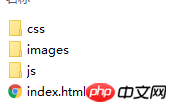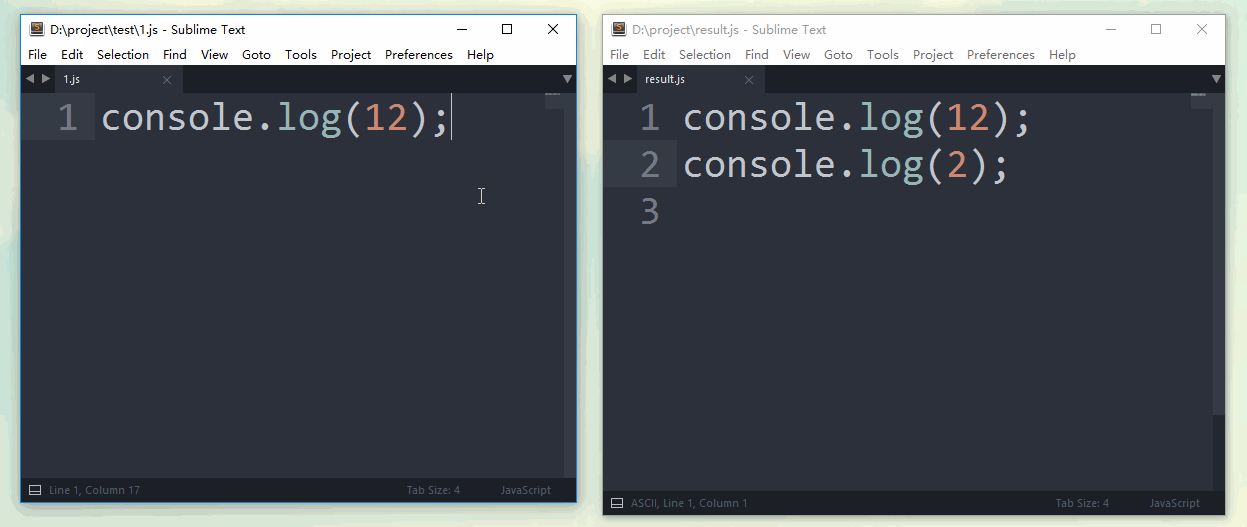How to implement project building and file merging in js?
Previous words
Generally, we use build tools to complete the automation of projects. This article mainly introduces how to use nodeJS to implement simple project structure construction and file merging
Project construction
Assume that the final project name is 'test' and the structure is as follows As shown in the figure

Then, first you need to set up a JSON object to save the directory structure to be created
var projectData = {'name' : 'test','fileData' : [
{'name' : 'css','type' : 'dir'},
{'name' : 'js','type' : 'dir'},
{'name' : 'images','type' : 'dir'},
{'name' : 'index.html','type' : 'file','content' : '<html>\n\t<head>\n\t\t<title>title</title>\n\t</head>\n\t<body>\n\t\t<h1>Hello</h1>\n\t</body>\n</html>',
}
]
};Directory structure The creation logic is as follows
var fs = require('fs');if ( projectData.name ) {
fs.mkdirSync(projectData.name);var fileData = projectData.fileData;if ( fileData && fileData.forEach ) {
fileData.forEach(function(f) {
f.path = projectData.name + '/' + f.name;
f.content = f.content || '';switch (f.type) {case 'dir':
fs.mkdirSync(f.path);break;case 'file':
fs.writeFileSync(f.path, f.content);break;default :break;
}
});
}
}
File merging
Assume that the goal is to merge the files in the 'test' directory All js files. The 'test' directory structure is as follows, including 1.js and 2.js in the js folder
1.js js2.js
Among them, the contents of 1.js and 2.js are as follows
//1.jsconsole.log(1);//2.jsconsole.log(2);
Before merging these two files, you first need to implement a directory traversal function to traverse the 'test' directory. According to the directory traversal chapter in the nodejs file operation blog, you can get the following code
function travel(dir, callback) {
fs.readdirSync(dir).forEach(function (file) {var pathname = path.join(dir, file);if (fs.statSync(pathname).isDirectory()) {
travel(pathname, callback);
} else {
callback(pathname);
}
});
}The logic of file merging is as follows
var fs = require('fs');var path = require('path');var path = require('path');var filedir = './test';
fs.watch(filedir, function(ev, file) {//用于存放所有的js文件var arr = [];//将每一个js文件的路径存到arr数组中function travel(dir) {
fs.readdirSync(dir).forEach(function (file) {var pathname = path.join(dir, file); if (fs.statSync(pathname).isDirectory()) {
travel(pathname);
} else {
arr.push(pathname);
}
});
} //只要有一个文件发生了变化,我们就需要对这个文件夹下的所有文件进行读取,然后合并 travel(filedir);//读取数组arr中的文件内容,并合并function concat(arr){var content = '';
arr.forEach(function(item) {var c = fs.readFileSync(item);
content += c.toString() + '\n';
});
fs.writeFile('./result.js', content);
}
concat(arr);
});In this way, when the content of the 1.js file changes, the merged result file result.js It will take effect immediately and be re-merged into the latest content

The above is the detailed content of How to implement project building and file merging in js?. For more information, please follow other related articles on the PHP Chinese website!

Hot AI Tools

Undresser.AI Undress
AI-powered app for creating realistic nude photos

AI Clothes Remover
Online AI tool for removing clothes from photos.

Undress AI Tool
Undress images for free

Clothoff.io
AI clothes remover

Video Face Swap
Swap faces in any video effortlessly with our completely free AI face swap tool!

Hot Article

Hot Tools

Notepad++7.3.1
Easy-to-use and free code editor

SublimeText3 Chinese version
Chinese version, very easy to use

Zend Studio 13.0.1
Powerful PHP integrated development environment

Dreamweaver CS6
Visual web development tools

SublimeText3 Mac version
God-level code editing software (SublimeText3)

Hot Topics
 BTCC tutorial: How to bind and use MetaMask wallet on BTCC exchange?
Apr 26, 2024 am 09:40 AM
BTCC tutorial: How to bind and use MetaMask wallet on BTCC exchange?
Apr 26, 2024 am 09:40 AM
MetaMask (also called Little Fox Wallet in Chinese) is a free and well-received encryption wallet software. Currently, BTCC supports binding to the MetaMask wallet. After binding, you can use the MetaMask wallet to quickly log in, store value, buy coins, etc., and you can also get 20 USDT trial bonus for the first time binding. In the BTCCMetaMask wallet tutorial, we will introduce in detail how to register and use MetaMask, and how to bind and use the Little Fox wallet in BTCC. What is MetaMask wallet? With over 30 million users, MetaMask Little Fox Wallet is one of the most popular cryptocurrency wallets today. It is free to use and can be installed on the network as an extension
 Is nodejs a backend framework?
Apr 21, 2024 am 05:09 AM
Is nodejs a backend framework?
Apr 21, 2024 am 05:09 AM
Node.js can be used as a backend framework as it offers features such as high performance, scalability, cross-platform support, rich ecosystem, and ease of development.
 How to connect nodejs to mysql database
Apr 21, 2024 am 06:13 AM
How to connect nodejs to mysql database
Apr 21, 2024 am 06:13 AM
To connect to a MySQL database, you need to follow these steps: Install the mysql2 driver. Use mysql2.createConnection() to create a connection object that contains the host address, port, username, password, and database name. Use connection.query() to perform queries. Finally use connection.end() to end the connection.
 What are the global variables in nodejs
Apr 21, 2024 am 04:54 AM
What are the global variables in nodejs
Apr 21, 2024 am 04:54 AM
The following global variables exist in Node.js: Global object: global Core module: process, console, require Runtime environment variables: __dirname, __filename, __line, __column Constants: undefined, null, NaN, Infinity, -Infinity
 What is the difference between npm and npm.cmd files in the nodejs installation directory?
Apr 21, 2024 am 05:18 AM
What is the difference between npm and npm.cmd files in the nodejs installation directory?
Apr 21, 2024 am 05:18 AM
There are two npm-related files in the Node.js installation directory: npm and npm.cmd. The differences are as follows: different extensions: npm is an executable file, and npm.cmd is a command window shortcut. Windows users: npm.cmd can be used from the command prompt, npm can only be run from the command line. Compatibility: npm.cmd is specific to Windows systems, npm is available cross-platform. Usage recommendations: Windows users use npm.cmd, other operating systems use npm.
 Is there a big difference between nodejs and java?
Apr 21, 2024 am 06:12 AM
Is there a big difference between nodejs and java?
Apr 21, 2024 am 06:12 AM
The main differences between Node.js and Java are design and features: Event-driven vs. thread-driven: Node.js is event-driven and Java is thread-driven. Single-threaded vs. multi-threaded: Node.js uses a single-threaded event loop, and Java uses a multi-threaded architecture. Runtime environment: Node.js runs on the V8 JavaScript engine, while Java runs on the JVM. Syntax: Node.js uses JavaScript syntax, while Java uses Java syntax. Purpose: Node.js is suitable for I/O-intensive tasks, while Java is suitable for large enterprise applications.
 Is nodejs a back-end development language?
Apr 21, 2024 am 05:09 AM
Is nodejs a back-end development language?
Apr 21, 2024 am 05:09 AM
Yes, Node.js is a backend development language. It is used for back-end development, including handling server-side business logic, managing database connections, and providing APIs.
 Can nodejs write front-end?
Apr 21, 2024 am 05:00 AM
Can nodejs write front-end?
Apr 21, 2024 am 05:00 AM
Yes, Node.js can be used for front-end development, and key advantages include high performance, rich ecosystem, and cross-platform compatibility. Considerations to consider are learning curve, tool support, and small community size.






